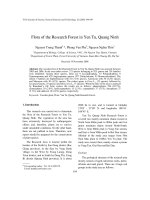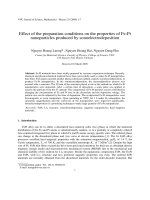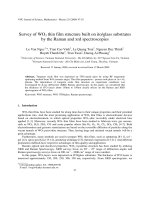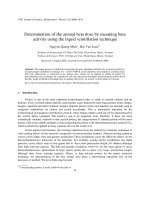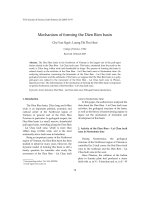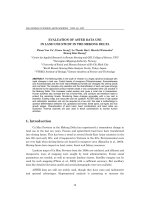Tài liệu Báo cáo " STABILITY OF THE ELASTOPLASTIC THIN ROUND CYLINDRICAL SHELLS SUBJECTED TO TORSIONAL MOMENT AT TWO EXTREMITIES " pptx
Bạn đang xem bản rút gọn của tài liệu. Xem và tải ngay bản đầy đủ của tài liệu tại đây (165.98 KB, 9 trang )
VNU. JOURNAL OF SCIENCE, Mathematics - Physics. T.XXI, N
0
3 - 2005
STABILITY OF THE ELASTOPLASTIC THIN
ROUND CYLINDRICAL SHELLS SUBJECTED TO
TORSIONALMOMENTATTWOEXTREMITIES
Dao Van Dung, Hoang Van Tung
Department of Mathematics, College of Sciences, VNU
Abstract.
An elastic stability problem of the thin round cylindrical shells subjected to
torsional moment at two extremities has been investigated in the paper [6]. By the small
elastoplastic deformation theory and by the flow theory, this problem again has been
studied in [2] and [4]. Basing on the theory of elastoplastic p rocesses the above mentioned
problem has been solved by approach simulation of instability form of the cylinder (see
[1],[5]). In this paper, the solution of problem in the real bending form of structure has
been found. We have also established the relations for determining critical force. Some
numerical results for a linear hardening material have been given and discussed.
1. Stability problem of cylindrical shell
Let us consider a thin round cylindrical shell of strength L, thickness h and radius
of the middle surface equal to R. We choose a orthogonal coordinate system Oxyz so that
axis x lies along the generatrix of cylindrical shell while y = Rθ with θ- the angle circular
arc and z in direction of the normal to cylindrical shell.
Suppose that cylindrical shell has the simply supported boundary constraints at
x =0,x = L and subjected to torsion by a couple of moments M
k
=2πR
2
hp, p = p(t)
with t-loading parameter. Moreover, we assume that material is incompressible and don’t
take into account the unloading in the cylindrical shell. We have to find the critical values
t = t
∗
and p
∗
= p(t
∗
) which at that time an instability of the structure appears. We use
the criterion of bifurcation of equilibrium states to study the proposed problem.
2. Fundamental equations of the stability problem
2.1. Pre-buckling process
At the any moment in the pre-buckling state, we have
σ
12
= −p, σ
ij
=0 ∀i =1,j=2.
σ
u
=
√
3|σ
12
| =
√
3p.
The components of the strain velocity tensor determined respectively
˙ε
12
= −
3 ˙p
2φ
, ˙ε
ij
=0 ∀i =1,j =2 , φ
≡ φ
(s).
Typeset by A
M
S-T
E
X
24
Stability of the elastoplastic thin round cylindrical shells subjected to 25
The arc-length of the strain trajectory is calculated by the formula
ds
dt
=
2
√
3
| ˙ε
12
| =
√
3 ˙p
φ
.
It is seen from here that φ(s)=
√
3p or s = φ
−1
(
√
3p).
2.2. Post-buckling process and boundary conditions
The system of stability equations of the thin cylindrical shell established in [1,5] are
writteninform
α
1
∂
4
δw
∂x
4
+ α
3
∂
4
δw
∂x
2
∂y
2
+ α
5
∂
4
δw
∂y
4
−
9
h
2
N
w
−2p
∂
2
δw
∂x∂y
+
1
R
∂
2
ϕ
∂x
2
W
= 0; (2.1)
β
1
∂
4
ϕ
∂x
4
+ β
3
∂
4
ϕ
∂x
2
∂y
2
+ β
5
∂
4
ϕ
∂y
4
+
N
R
∂
2
δw
∂x
2
=0, (2.2)
where
α
1
=1, α
3
=1+
φ
N
, α
5
=1;
β
1
=1, β
3
=3
N
φ
− 1, β
5
=1;
φ
= φ
(s),N=
σ
u
s
.
The simply supported boundary conditions give us
δw
e
e
e
x=0,x=L
=0,
∂
2
δw
∂x
2
e
e
e
x=0,x=L
=0. (2.3)
3. Solving method
From the experimental results (see [2]) and the similar form of solution in [3], we
find the real deflection δw in form
δw = A
1
cos
πx
L
cos
n
R
(y + γx), (3.1)
where γ is the tangent of skew angle of summit of waves in comparison with the generatrix
of cylindrical shell, n-number of waves in direction of round arc. The just chosen solution
satisfies the simply supported boundary condition in the sense of Saint-Venant at x =
0,x= L. In fact,
8
2πR
0
δw(0,y)dy =
8
2πR
0
A
1
cos
ny
R
dy =0
8
2πR
0
δw(L, y)dy = −
8
2πR
0
A
1
cos
n
R
(y + γL)dy =0
8
2πR
0
∂
2
δw
∂x
2
(0,y)dy = −
8
2πR
0
A
1
^
p
π
L
Q
2
+
p
nγ
R
Q
2
cos
ny
R
dy =0
8
2πR
0
∂
2
δw
∂x
2
(L, y)dy =
8
2πR
0
A
1
^
p
π
L
Q
2
+
p
nγ
R
Q
2
cos
n
R
(y + γL)dy =0
26 Dao Van Dung, Hoang Van Tung
In order to solve advantageously the problem, we rewrite the expression of δw in form
δw =
A
1
2
cos
p
ny
R
+ mx
Q
+
A
1
2
cos
p
ny
R
+ jx
Q
, (3.2)
where
m =
nγ
R
+
π
L
,j=
nγ
R
−
π
L
.
Now we find the particular solution ϕ of equation (2.2) in form
ϕ = B
1
cos
p
ny
R
+ mx
Q
+ B
2
cos
p
ny
R
+ jx
Q
. (3.3)
Substituting (3.2), (3.3) into (2.2) and comparing the coefficients of cos
D
ny
R
+ mx
i
and
cos
D
ny
R
+ jx
i
,weobtainB
1
= A
1
B
01
,B
2
= A
1
B
02
where
B
01
=
Nm
2
2R
1
β
1
m
4
+ β
3
m
2
D
n
R
i
2
+ β
5
D
n
R
i
4
;
B
02
=
Nj
2
2R
1
β
1
j
4
+ β
3
j
2
D
n
R
i
2
+ β
5
D
n
R
i
4
.
Putting δw and ϕ into (2.1) and because of the condition on the existence of non-trivial
solution, we get
9np
h
2
NR
=
α
1
m
3
2
+
α
3
m
2
p
n
R
Q
2
+
α
5
2m
p
n
R
Q
4
+
9mB
01
h
2
NR
; (3.4)
9np
h
2
NR
=
α
1
j
3
2
+
α
3
j
2
p
n
R
Q
2
+
α
5
2j
p
n
R
Q
4
+
9jB
02
h
2
NR
. (3.5)
We receive from here the expression for determining critical load
α
1
m
3
2
+
α
3
m
2
p
n
R
Q
2
+
α
5
2m
p
n
R
Q
4
+
9mB
01
h
2
NR
=
α
1
j
3
2
+
α
3
j
2
p
n
R
Q
2
+
α
5
2j
p
n
R
Q
4
+
9jB
02
h
2
NR
.
Substituting the expression of B
01
and B
02
into the just obtained equation, we have
α
1
m
3
2
+
α
3
m
2
p
n
R
Q
2
+
α
5
2m
p
n
R
Q
4
+
9m
3
2R
2
h
2
1
β
1
m
4
+ β
3
m
2
D
n
R
i
2
+ β
5
D
n
R
i
4
=
=
α
1
j
3
2
+
α
3
j
2
p
n
R
Q
2
+
α
5
2j
p
n
R
Q
4
+
9j
3
2R
2
h
2
1
β
1
j
4
+ β
3
j
2
D
n
R
i
2
+ β
5
D
n
R
i
4
(3.6)
Remarks
a) If material is elastic, i.e. N =3G, φ
=3G, we get
α
1
= α
5
=1, α
3
=2; β
1
= β
5
=1, β
3
=2.
Stability of the elastoplastic thin round cylindrical shells subjected to 27
The expression (3.4) and (3.5) are of the form
2p
3G
=
(m
2
R
2
+ n
2
)
2
9mnR
w
h
R
W
2
+
m
3
R
3
n(m
2
R
2
+ n
2
)
2
,
2p
3G
=
(j
2
R
2
+ n
2
)
2
9jnR
w
h
R
W
2
+
j
3
R
3
n(j
2
R
2
+ n
2
)
2
.
These results coincides with the previous well-known ones (see [2]).
b) If material is small elasto-plastic i.e. φ
= E
t
,N= E
c
,then
α
1
= α
5
=1, α
3
=1+
E
t
E
c
; β
1
= β
5
=1, β
3
=3
E
c
E
t
− 1 .
The expression (3.4) and (3.5) return to the results presented in [2].
4. Linear hardening material
In this case, we have
φ
≡ g = const, σ
u
=3Gs
0
+(s − s
0
)φ
= gs +(3G −g)s
0
.
Putting λ =(3G − g)s
0
,weobtainσ
u
= gs + λ,
α
1
= α
5
=1, α
3
=1+
φ
N
=1+
gs
σ
u
=
2gs + λ
gs + λ
β
1
= β
5
=1, β
3
=3
N
φ
− 1=3
σ
u
gs
− 1=2+
3λ
gs
.
Substituting these values into (3.6), we obtain equation
a
1
+
a
2
s
gs + λ
+
a
3
gs
a
4
gs + a
5
= b
1
+
b
2
s
gs + λ
+
b
3
gs
b
4
gs + b
5
, (4.1)
where
a
1
=
1
2
m
3
+
1
2
m
p
n
R
Q
2
+
1
2m
p
n
R
Q
4
,a
5
=3λm
2
p
n
R
Q
2
,
a
2
=
1
2
mg
p
n
R
Q
2
,a
3
=
9m
3
2R
2
h
2
,a
4
= m
4
+2m
2
p
n
R
Q
2
+
p
n
R
Q
4
,
b
1
=
1
2
j
3
+
1
2
j
p
n
R
Q
2
+
1
2j
p
n
R
Q
4
,b
5
=3λj
2
p
n
R
Q
2
,
b
2
=
1
2
jg
p
n
R
Q
2
,b
3
=
9j
3
2R
2
h
2
,b
4
= j
4
+2j
2
p
n
R
Q
2
+
p
n
R
Q
4
.
Transforming (4.1), we receive three-order algebraic equation of s
As
3
+ Bs
2
+ Cs + D =0, (4.2)
28 Dao Van Dung, Hoang Van Tung
where
A = b
4
g
2
(a
1
a
4
g + a
3
g + a
2
a
4
) − a
4
g
2
(b
1
b
4
g + b
3
g + b
2
b
4
)
B = b
5
g(a
1
a
4
g+a
3
g+a
2
a
4
)−a
5
g(b
1
b
4
g+b
3
g+b
2
b
4
)+b
4
g(λa
1
a
4
g+λa
3
g+a
1
a
5
g+a
2
a
5
)−
−a
4
g(λb
1
b
4
g + λb
3
g + b
1
b
5
g + b
2
b
5
)
C = b
5
(λa
1
a
4
g+λa
3
g+a
1
a
5
g+a
2
a
5
)−a
5
(λb
1
b
4
g+λb
3
g+b
1
b
5
g+b
2
b
5
)+λg(b
4
a
1
a
5
−a
4
b
1
b
5
)
D = λ(a
1
a
5
b
5
− b
1
b
5
a
5
) .
It is seen that for each given material and each determined value of γ ,withn changing
from 1 to k , then we can solve equation (4.2) for finding s
n
. After that we choose value
s
min
= min(s
1
,s
2
, , s
k
). Finally, the critical load is found by putting s
min
into the
expression of σ
u
σ
umin
= φ
s
min
+(3G − φ
)s
0
,p
min
=
1
√
3
σ
umin
.
R/h s.10
3
σ
∗
u
(Mpa)
25 18.4 750.61
28 11.68 610.83
31 8.3 540.53
34 6.3 498.93
37 4.978 471.43
40 4.061 452.36
43 3.4 438.61
46 2.879 427.77
49 2.48 419.47
52 2.164 413
55 1.907 407.55
58 1.694 403.12
61 1.516 399.42
64 1.366 396.3
67 1.238 393.64
70 1.128 391.35
73 1.032 389.35
76 0.948 387.61
79 0.8745 386.08
Table 1. The results basing on the elasto-plastic theory
Stability of the elastoplastic thin round cylindrical shells subjected to 29
5. Numerical results and discussion
Example 1: Let us consider material with the characteristics as follow 3G =
2, 6.10
5
Mpa ; φ
=0, 208.10
5
Mpa ; γ =0, 5; R =4; L = 10; n from1to14(L, R, h in
metres). The numerical results basing on the theory of elasto-plastic processes are given
in table 1.
The calculating results based on the elastic theory are presented in table 2. Figure
1 is graph of the elasto-plastic instability case . The comparison between the elasto-plastic
instability and the elastic instability is introduced in figure 2.
R/h s.10
3
σ
∗
u
(Mpa)
25 16.7 4342
28 14.4 3744
31 12.8 3328
34 11.3 2938
37 10.1 2626
40 9.1 2366
43 8.3 2158
46 7.7 2002
49 7.1 1846
52 6.7 1742
55 6.3 1638
58 5.9 1534
61 5.5 1430
64 5.2 1352
67 4.9 1274
70 4.7 1222
73 4.5 1170
76 4.3 1118
79 4.2 1092
82 4 1042
85 3.8 988
88 3.6 936
Table 2. The calculating results according to the elastic theory
30 Dao Van Dung, Hoang Van Tung
.
Stability of the elastoplastic thin round cylindrical shells subjected to 31
.
32 Dao Van Dung, Hoang Van Tung
Example 2: Let us consider material with the characteristics as follows
3G =2, 6.10
5
Mpa , φ
=0, 208.10
5
Mpa , γ =
√
3
3
,R=5,L=10
The results of calculation are sketched by graphs in figures 3 and 4.
Discussion
The above received results lead us to some remarks as follows
a) The critical loads determined according to the elastic theory are much greater than
those according to the theory of elasto-plastic processes when the thickness of cylin-
drical shell is greater. Because these don’t exactly describe mechanical characteris-
tics, investigating must be based on the theory of elasto-plastic processes for thicker
cylindrical shells.
b) When the slenderness of cylindrical shell reachs a determined value, the difference
between the critical loads found by basing on two theories is very little. Therefore
for the slender cylindrical shells, calculating based on the elastic theory is reliable.
c) The expression of deflection δw in (3.1) has exactly described real bending form of
structure.
This paper is completed with financial support from the National Basic Research
Program In Natural Sciences.
References
1. Dao Huy Bich, Theory of elastoplastic processes, Vietnam National University Pub-
lishing House, Hanoi 1999 (in Vietnamese).
2. Volmir A.S.Stability of deformable systems , Moscow 1963 (in Russian).
3. Dao Huy Bich, On the elastoplastic stability of a plate under shear forces, taking
into account its real bending form, Vietnam Journal of Mech, NCST of Vietnam,
Vol 23, No 1(2001), pp 6-16.
4. G.Gerard, Plastic stability theory of thin shell, J.Aeron. Sci., 24, No 4(1957), pp
264-279.
5. Dao Van Dung, Stability problem outside elastic limit according to the theory of
elastoplastic deformation processes, Ph. D. Thesis, Hanoi 1993 (in Vietnamese).
6. L.H. Donnell, Stability of thin walled tubes under torsion, NACA Rept. No 479(1933).
